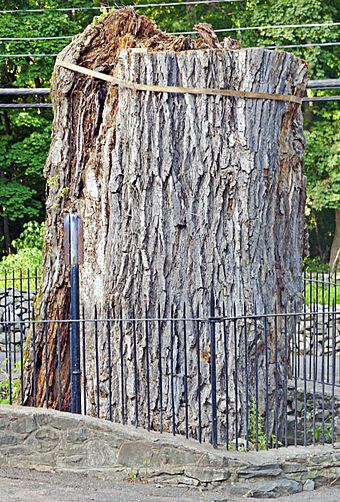Balmville Tree facts for kids
Quick facts for kids |
|
|
Bloomer-Dailey House and Balmville Tree
|
|

Stump of the tree in 2015
|
|
| Location | 83 Balmville Rd, Balmville, New York |
|---|---|
| Area | 2 acres (0.81 ha) |
| Built | 1750 |
| Architectural style | Colonial, Colonial Revival |
| NRHP reference No. | 00001420 |
| Added to NRHP | December 7, 2000 |
The Balmville Tree was a very old cottonwood tree. It grew where River Road, Balmville Road, and Commonwealth Avenue meet in Balmville, a small community in the Town of Newburgh. This tree was the oldest of its kind in the entire Eastern United States.
People first thought it was a "Balm-of-Gilead" tree. This is how the nearby community got its name. By the late 1900s, the tree was so big that some thought it might be a danger to traffic. But the community worked hard to save it. Because of their efforts, the tree and a nearby house were listed on the National Register of Historic Places in 2000. The state then took over the land, making it New York's smallest state forest. Sadly, the tree kept having problems with its structure. It was finally cut down in 2015.
Contents
History of the Balmville Tree
How Old Was the Balmville Tree?
Local stories say that the tree grew from a walking stick planted by George Washington. This was supposedly during the Revolutionary War. Washington and his army were staying nearby in Newburgh at the time.
However, scientists took samples from the tree's core. They found that the tree started growing in 1699. This was long before America became independent. Franklin D. Roosevelt, a former president, often came to visit the tree.
Efforts to Save the Historic Tree
In the mid-1900s, the tree began to show its age. It also suffered from people damaging it. In the 1970s, tree experts suggested cutting it down. They said it was a danger to traffic.
But community groups, led by Richard Severo, fought to save it. They pointed out its important history. Because of their efforts, the tree received protection from the state and federal governments.
Protecting the Balmville Tree
An advanced system of wires and a metal pole helped support the tree. The small piece of land where it grew was also protected. The New York State Office of Parks, Recreation and Historic Preservation called it a historic site. The New York State Department of Environmental Conservation called it a "public historic park" or state forest. At only 348 square feet (31 m2), it was New York's smallest state forest. The tree was listed on the National Register of Historic Places in 2000.
Passing on the Tree's Legacy
On March 27, 2009, community members gathered around the tree. Workers used special lifts to trim its branches. Gardeners from local clubs took small buds from the tree. They hoped to grow these buds into new trees. The goal was to plant any successful new trees at other historic places. A local newspaper headline said, "Balmville Tree's Longevity Could be Passed on to Descendents."
Richard and Emoke Severo, who lived next to the tree, were the only ones to successfully grow a cutting. They tried four times in 1999, the tree's 300th year. Only one cutting survived. They believe it was because the cutting shared the same water and soil as the original tree.
The Tree's Final Days
On August 5, 2015, the tree was cut down. The New York State Department of Environmental Protection removed it due to safety worries. For several weeks before, nearby roads were closed. This was because the tree was getting worse quickly, and branches were falling.
Residents did not protest, but they were sad to see it go. One person told a local newspaper, "There is no Balmville without the Balmville Tree."
A 15-foot (4.6 m) tall stump of the tree remains. This area is still protected. Residents plan to hold a new dedication ceremony for the stump. Many people also took cuttings from the tree. They hope to plant them and keep the tree's genes alive.
Measurements of the Balmville Tree
When the tree was cut down, its base was 25 feet (7.6 m) around. It stood 83 feet (25 m) tall. The tree once reached 110 feet (33.5 m) high. But its top part had to be trimmed. This was after it was badly damaged by Hurricane Floyd in 1999.
Images for kids




